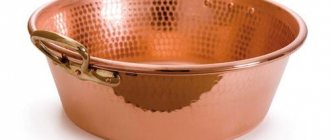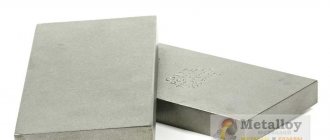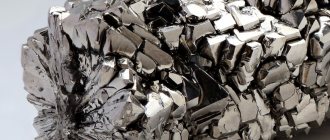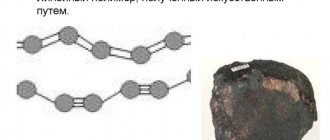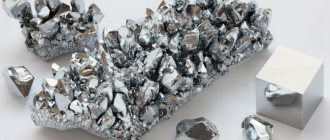In the periodic table, the chemical element titanium is designated as Ti (Titanium) and is located in a secondary subgroup of group IV, in the 4th period under atomic number 22. It is a silvery-white solid metal that is part of a large number of minerals. You can buy titanium on our website.
Titanium was discovered at the end of the 18th century by chemists from England and Germany, William Gregor and Martin Klaproth, independently of each other with a six-year difference. The name of the element was given by Martin Klaproth in honor of the ancient Greek characters of the titans (huge, strong, immortal creatures). As it turned out, the name became prophetic, but it took humanity more than 150 years to become familiar with all the properties of titanium. Only three decades later it was possible to obtain the first sample of titanium metal. At that time, it was practically not used due to its fragility. In 1925, after a series of experiments, using the iodide method, chemists Van Arkel and De Boer extracted pure titanium.
Due to the valuable properties of the metal, engineers and designers immediately paid attention to it. It was a real breakthrough. In 1940, Kroll developed a magnesium-thermal method for obtaining titanium from ore. This method is still relevant today.
Physical and mechanical properties
Titanium is a fairly refractory metal. Its melting point is 1668±3°C. In this indicator, it is inferior to such metals as tantalum, tungsten, rhenium, niobium, molybdenum, tantalum, zirconium. Titanium is a paramagnetic metal. In a magnetic field it is not magnetized, but is not pushed out of it. Image 2 Titanium has a low density (4.5 g/cm³) and high strength (up to 140 kg/mm²). These properties practically do not change at high temperatures. It is more than 1.5 times heavier than aluminum (2.7 g/cm³), but 1.5 times lighter than iron (7.8 g/cm³). In terms of mechanical properties, titanium is much superior to these metals. In terms of strength, titanium and its alloys are on par with many grades of alloy steel.
Titanium is as resistant to corrosion as platinum. The metal has excellent resistance to cavitation conditions. Air bubbles formed in a liquid medium during active movement of a titanium part practically do not destroy it.
It is a durable metal that can resist fracture and plastic deformation. It is 12 times harder than aluminum and 4 times harder than copper and iron. Another important indicator is the yield strength. As this indicator increases, the resistance of titanium parts to operational loads improves.
In alloys with certain metals (especially nickel and hydrogen), titanium is able to “remember” the shape of the product created at a certain temperature. Such a product can then be deformed and it will retain this position for a long time. If the product is heated to the temperature at which it was made, then the product will take its original shape. This property is called “memory”.
The thermal conductivity of titanium is relatively low and the coefficient of linear expansion is correspondingly low. It follows from this that metal is a poor conductor of electricity and heat. But at low temperatures it is a superconductor of electricity, which allows it to transmit energy over considerable distances. Titanium also has high electrical resistance. Pure titanium metal is subject to various types of cold and hot processing. It can be drawn and wired, forged, rolled into strips, sheets and foil with a thickness of up to 0.01 mm. The following types of rolled products are made from titanium: titanium strip , titanium wire , titanium pipes , titanium bushings , titanium circle , titanium rod .
A.A. Shcherbakov. "Pilots, planes, tests"
Winged metal titanium
In the sixties, titanium began to be used in the production of aircraft engines. This metal had advantages over steel in terms of specific gravity, mechanical properties and thermal strength. Its use in engines made it possible to reduce their specific weight. But its use required some technological and design innovations: in addition to useful qualities, it had a low combustion temperature; when ignited, it turned into a terrible destructive force. If there was a fuel fire on the plane, the combustion temperature reached a little over 1000. Such a fire gave the crew time to detect it and apply extinguishing measures or abandon the aircraft. When titanium burns, the temperature reaches 3000. The flames of such a fire cut through the structure like a heated knife through butter. The destruction is happening so rapidly that the crew finds itself in an extremely difficult situation. Under normal conditions, titanium cannot ignite, even when it reaches the combustion temperature; it requires too much oxygen to burn. But in a jet engine, in which the compressor is made of titanium, the temperature is quite high, and there is more than enough oxygen: hundreds of cubic meters of air per second pass through the compressor. If, due to a decrease in the gap between the compressor blades and the housing, even a slight touch or a very slight scratching occurs, then it’s better not to say anything! Burning titanium is a volcano inside a jet engine. Here's how it happened in practice. An emergency commission has been sent to the Siberian plant. The Su-24 acceptance test program provides for a “squeeze” in speed. This means that at an altitude of 1000 meters you need to get a speed of 1400 kilometers per hour. A special route has been set aside for this so that supersonic impacts do not disturb residents of nearby villages. During this regime, the crew ejected. The pilot landed normally. The navigator's leg was torn off up to the hip, and he died from shock and blood loss. The pilot could not understand or tell how and what happened. Residents of a village located not far from the highway, who often saw planes flying along it, did not even recognize the plane this time. They said that some kind of fiery barrel was rolling across the sky. During the investigation process, a “layout” of parts brought from the crash site is made. An outline of the aircraft is drawn on the concrete floor of the hangar and debris is placed on it according to its position on the aircraft. The commission members examine the details with surprise and bewilderment. The massive spar at one end looked quite normal, but at the other it looked like a washcloth. This is what a titanium flame can do to metal. A wing console was found with traces of blood and human flesh. It was she who tore off the navigator's leg. But she was behind the trajectory of the ejection seat. No one could understand how this could happen. Even during Khrushchev’s time, combat aircraft were cut using electric welding. Beautiful new cars, having lost the connection and support between their parts, turned into piles of scrap metal. What if this happens in the air at a speed of 1400 kilometers per hour? No computers, no modeling can predict or explain in this case the movement of aircraft parts. This is what a titanium fire is in flight. In this case, it was recorded completely reliably. Unfortunately, the described case was not the only one. At LII, pilot Alexander Andreevich Muravyov, on a plane with the same engine as the Su-24, performed a high-speed landing. And suddenly. Absolutely inconceivable movement of the aircraft. Muravyov knew well all conceivable types of movement, up to and including the corkscrew. But then something incredible happened: the plane seemed to somersault over its head. Alexander managed to eject safely. A titanium fire was also installed. Another titanium fire was the cause of the crash of an experienced MiG-29. Fortunately, Valery Menitsky was also able to eject. Subsequently, engine designers found safe ways to use titanium, and now it behaves quite loyally in aircraft engines.
Chemical properties
Pure titanium is a chemically active element. Due to the fact that a dense protective film is formed on its surface, the metal is highly resistant to corrosion. It does not undergo oxidation in air, in salty sea water, and does not change in many aggressive chemical environments (for example: diluted and concentrated nitric acid, aqua regia). At high temperatures, titanium interacts with reagents much more actively. In air at a temperature of 1200°C, it ignites. When ignited, the metal gives off a bright glow. An active reaction also occurs with nitrogen, with the formation of a yellow-brown nitride film on the surface of titanium.
Reactions with hydrochloric and sulfuric acids at room temperature are weak, but when heated, the metal dissolves intensively. As a result of the reaction, lower chlorides and monosulfate are formed. Weak interactions also occur with phosphoric and nitric acids. The metal reacts with halogens. The reaction with chlorine occurs at 300°C. An active reaction with hydrogen occurs at a temperature slightly above room temperature. Titanium actively absorbs hydrogen. 1 g of titanium can absorb up to 400 cm³ of hydrogen. Heated metal decomposes carbon dioxide and water vapor. Interaction with water vapor occurs at temperatures above 800°C. As a result of the reaction, metal oxide is formed and hydrogen evaporates. At higher temperatures, hot titanium absorbs carbon dioxide and forms carbide and oxide.
Characteristics of titanium alloys
Several components are used to alloy titanium:
- Aluminum is the most common additive. It increases specific strength, elasticity, and creep resistance.
- Tin slows down oxidation when heated, increases ductility and weldability.
- Thanks to zirconium, Ti-Al-Zr is deformable at room temperature.
- Manganese increases the ability to deform.
- Silicon improves crack resistance.
- Vanadium – weldability.
- The Ti-Al-Mo-Cr-Fe-Si system is highly durable. This is a martensitic metal.
- Molybdenum increases the heat resistance of titanium.
Pure titanium has a tensile strength of up to 450 MPa, alloying additives can increase it to 2000 MPa. When titanium cools, its flexural strength increases. At room temperature it is 700 MPa, around -200°C it increases to 1100 MPa.
Physical properties
Main characteristics of titanium:
- temperatures: melting 1668 degrees Celsius, boiling – 3227;
- yield strength: from 250 to 380 MPa;
- elasticity – 110 GPa, varies in different directions;
- the average hardness of alloys according to HB is 103;
- density: at room temperature 4500 kg/m3, at melting point - 4120 kg/m3;
- heat capacity – 531 J per kilogram when heated by a degree;
- thermal conductivity – 18 W/(m deg);
- resistivity – 42.1·10 -6 Ohm·cm.
When cooled to 3.8°K (-270°C), the metal becomes a superconductor.
Chemical properties
In the solid state, Ti is chemically stable and does not oxidize in high humidity, marine atmosphere, or in contact with aggressive environments. When heated to the melting point, it becomes active. Interacts with all air components:
- oxygen, solid oxides are formed;
- nitrogen, it strengthens the structure, increases the tensile strength, the critical concentration is 0.2%, above this indicator the metal becomes brittle;
- hydrogen degrades technological properties;
- carbon increases the temperature of phase changes.
When heated to the melting point, the metal must be insulated.
Methods of obtaining
Titanium is one of the most abundant elements on Earth. Its content in the bowels of the planet by mass is 0.57%. The highest concentration of the metal is observed in the “basalt shell” (0.9%), in granitic rocks (0.23%) and in ultramafic rocks (0.03%). There are about 70 titanium minerals in which it is found in the form of titanic acid or dioxide. The main minerals of titanium ores are: ilmenite, anatase, rutile, brookite, loparite, leucoxene, perovskite and sphene. The world's main titanium producers are the UK, USA, France, Japan, Canada, Italy, Spain and Belgium. There are several ways to obtain titanium. All of them are used in practice and are quite effective.
Magnesium-thermal process.
Ore containing titanium is mined and processed into dioxide, which is slowly and at very high temperatures subjected to chlorination. Chlorination is carried out in a carbon environment. The titanium chloride formed as a result of the reaction is then reduced with magnesium. The resulting metal is heated in vacuum equipment at high temperature. As a result, magnesium and magnesium chloride evaporate, leaving titanium with many pores and voids. Titanium sponge is melted down to produce high-quality metal.
Calcium hydride method.
First, titanium hydride is obtained, and then it is separated into its components: titanium and hydrogen. The process occurs in an airless space at high temperatures. Calcium oxide is formed, which is washed with weak acids. Calcium hydride and magnesium-thermal methods are commonly used on an industrial scale. These methods make it possible to obtain a significant amount of titanium in a short period of time, with minimal monetary costs.
Electrolysis method.
Titanium chloride or dioxide is exposed to high current. As a result, the compounds decompose.
Iodide method.
Titanium dioxide reacts with iodine vapor. Next, titanium iodide is exposed to high temperature, resulting in titanium. This method is the most effective, but also the most expensive. Titanium is obtained of very high purity without impurities or additives.
Metal structure
In appearance, the metal most closely resembles steel, but its mechanical qualities are higher. At the same time, titanium is lightweight - molecular weight 22. The physical properties of the element have been studied quite well, but they strongly depend on the purity of the metal, which leads to significant deviations.
In addition, its specific chemical properties are important. Titanium is resistant to alkalis and nitric acid, and at the same time reacts violently with dry halogens, and at higher temperatures with oxygen and nitrogen. Even worse, it begins to absorb hydrogen at room temperature if there is an active surface. And in the melt it absorbs oxygen and hydrogen so intensely that the melting has to be carried out in a vacuum.
Another important feature that determines physical characteristics is the existence of 2 phases of the state.
- Low temperature - α-Ti has a hexagonal close-packed lattice, the density of the substance is 4.55 g / cubic meter. cm (at 20 C).
- High temperature - β-Ti is characterized by a body-centered cubic lattice, the phase density is correspondingly lower - 4.32 g / cubic meter. see (at 900C).
Under normal conditions, the metal is covered with a protective oxide film. In its absence, titanium poses a great danger. Thus, titanium dust can explode, the temperature of such an explosion is 400C. Titanium shavings are a fire hazardous material and are stored in a special environment.
Next, we will consider the magnetic, mechanical, chemical and physical properties of titanium, its alloys and their applications.
The video below explains the structure and properties of titanium:
Application of titanium
Due to its good anti-corrosion properties, titanium is used for the manufacture of chemical equipment. The high heat resistance of the metal and its alloys facilitates its use in modern technology. Titanium alloys are an excellent material for aircraft, rocket and shipbuilding.
Monuments are made from titanium. And bells made of this metal are known for their extraordinary and very beautiful sound. Titanium dioxide is a component of some medications, for example: ointments against skin diseases. Metal compounds with nickel, aluminum and carbon are also in great demand.
Titanium and its alloys have found application in such areas as the chemical and food industries, non-ferrous metallurgy, electronics, nuclear engineering, power engineering, and electroplating. Weapons, armor plates, surgical instruments and implants, irrigation systems, sports equipment and even jewelry are made from titanium and its alloys. During the nitriding process, a golden film is formed on the surface of the metal, which is not inferior in beauty even to real gold.
Deposits of space material
The most common are ilmenite deposits, they amount to about 800 million tons. The reserves of rutile ores are much smaller, but if production continues to grow, all of them can provide humanity for another 100 years. In terms of titanium reserves, Russia is second only to China and has 20 explored deposits. Most of them are complex, where iron, phosphorus, vanadium and zirconium are also mined. Today, the Russian metallurgical industry is considered the world's largest titanium producer.
Extensive deposits are located in South Africa, Ukraine, Canada, the USA, Brazil, Australia, Sweden, Norway, Egypt, Kazakhstan, India and South Korea. They differ in the metal content in the ores and production volumes; geological surveys do not stop. Even on the Moon, reserves of titanium-containing ores have been discovered, some of them tens of times richer than large deposits on Earth. This allows us to hope for a reduction in market prices for the metal and an expansion in the scope of its use.
On the bottom line
Comparing steel to titanium is the best way to determine the best material for a project. However, it is important to understand that the choice of material between steel and titanium depends on the specific application.
The differences between titanium and steel can be attributed to various aspects such as mechanical properties. These differences provide insight into each metal.
Links to related sources:
Roshindustry specializes in high quality rapid prototyping, rapid small batch production and large batch production. The rapid prototype services we provide are professional engineering, CNC machining including CNC milling and lathe, Sheet metal fabrication or sheet metal prototyping, Die casting, metal stamping, Vacuum casting, 3D printing, SLA, Plastic extrusion prototyping and aluminum, Rapid tooling, Rapid injection molding, Surface finishing services and other China rapid prototyping services, please contact us now.
Source

